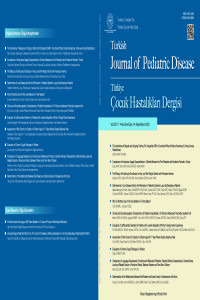Unusual surgical treatment option for an uncommon disease: Ureterocutaneostomy in an emphysemateous pyelonephritis patient.
Öz
Emphysematous pyelonephritis (EPN) is severe necrotising inflammation of renal parenchyma. Because of the devastating consequences of the pathology aggressive treatment can prevent permanent renal damage. Fifteen-year-old-girl patient without medical follow-up applied to emergency room with fever and vomiting. Computed Tomography (CT) revealed EPN. After diagnostic procedure minimal invasive procedures like double J catheter and nephrostomy tube insertion failed. While taking into account family’s treatment and medical follow-up compliance, also severe dilatation in both ureters made bilateral ureterocutaneostomy (UC) to be considered as a feasible option. UC creation can be thought as a safe and effective alternative surgical procedure. Pediatric neurogenic bladder (NB) population incompatible to treatment and follow-up are candidates for EPN development. We also believe that UC can be beneficial in terms of acute and long-term management of EPN in NB patients who the clinician thinks will not be compatible with complex surgical intervention, follow-up and treatment.
Anahtar Kelimeler
Kaynakça
- REFERENCES
- 1-Kitano H, Hieda K, Kitagawa H, Nakaoka Y, Koba Y, Ota K et al. Case Report: Emphysematous Pyelonephritis With a Congenital Giant Ureterocele. Front Pediatr. 2021;9:775468.
- 2-Kelly HA, MacCallum WG. Pneumaturia. JAMA. (1898) XXXI:375–81.
- 3- Pode D, Perlberg S, Fine H. Emphysematous renal and perirenal infection in nondiabetic patient. Urology. 1985;26(3):313-5.
- 4- Arsene C, Saste A, Arul S, Mestrovich J, Kammo R, Elbashir M et al. A case series of emphysematous pyelonephritis. Case Rep Med. 2014;2014:587926.
- 5- Lu YC, Chiang BJ, Pong YH, Chen CH, Pu YS, Hsueh PR et al. Emphysematous pyelonephritis: clinical characteristics and prognostic factors. Int J Urol. 2014 Mar;21:277-82.
- 6- Jiya FB, Ibitoye PK, Jiya NM, Amodu-Sanni M, Mohammed Y, Aquib DM et al. Emphysematous pyelonephritis in an infant from Sokoto, north-western Nigeria. Afr J Lab Med. 2021;10:1181.
- 7- Roberts JA. Management of pyelonephritis and upper urinary tract infections. Urol Clin North Am. 1999;26(4):753-63.
- 8- Huang JJ, Tseng CC. Emphysematous pyelonephritis: clinicoradiological classification, management, prognosis, and pathogenesis. Arch Intern Med. 2000;160(6):797-805.
- 9- Mohsin N, Budruddin M, Lala S, Al-Taie S. Emphysematous pyelonephritis: a case report series of four patients with review of literature. Ren Fail. 2009;31(7):597-601.
- 10- Turney JH. Renal conservation for gas-forming infections. Lancet. 2000;355(9206):770-1.
Nadir Bir Hastalık için Olağandışı Cerrahi Tedavi Seçeneği: Amfizematöz Piyelonefritli hastada Üreterokutanostomi
Öz
Amfizematöz piyelonefrit (AP), renal parankimin ileri derece nekrotizan inflamasyonudur. Patolojinin yıkıcı sonuçları nedeniyle agresif tedavi kalıcı böbrek hasarını önleyebilir. On beş yaşında takipsiz kız hasta acil servise ateş ve kusma şikayeti ile başvurdu. Bilgisayarlı Tomografi (BT) AP şeklinde rapor edildi. Tanı sürecinden sonra bilateral double J kateter veya nefrostomi gibi minimal invaziv girişimler başarısız oldu. Hastanın postür bozukluğu nedeniyle nefrostomi tüpü ile drenaj yapılamadı. Ailenin tedavisi ve tıbbi takip uyumu dikkate alınarak, her iki üreterde de ciddi dilate olması bilateral üreterokütanostominin (ÜK) uygun bir seçenek olarak düşünülmesine neden oldu. ÜK oluşturulması güvenli ve etkili alternatif bir cerrahi prosedür olarak düşünülebilir. Tedavi ve takibe uyumsuz pediatrik nörojen mesane (NB) popülasyonu, AP gelişimi için adaydır. Klinisyenin karmaşık cerrahi müdahale, takip ve tedavi ile uyumlu olmayacağını düşündüğü NB hastalarında ÜK’nin AP’in akut ve uzun süreli yönetimi açısından faydalı olabileceğine inanıyoruz.
Anahtar Kelimeler
Kaynakça
- REFERENCES
- 1-Kitano H, Hieda K, Kitagawa H, Nakaoka Y, Koba Y, Ota K et al. Case Report: Emphysematous Pyelonephritis With a Congenital Giant Ureterocele. Front Pediatr. 2021;9:775468.
- 2-Kelly HA, MacCallum WG. Pneumaturia. JAMA. (1898) XXXI:375–81.
- 3- Pode D, Perlberg S, Fine H. Emphysematous renal and perirenal infection in nondiabetic patient. Urology. 1985;26(3):313-5.
- 4- Arsene C, Saste A, Arul S, Mestrovich J, Kammo R, Elbashir M et al. A case series of emphysematous pyelonephritis. Case Rep Med. 2014;2014:587926.
- 5- Lu YC, Chiang BJ, Pong YH, Chen CH, Pu YS, Hsueh PR et al. Emphysematous pyelonephritis: clinical characteristics and prognostic factors. Int J Urol. 2014 Mar;21:277-82.
- 6- Jiya FB, Ibitoye PK, Jiya NM, Amodu-Sanni M, Mohammed Y, Aquib DM et al. Emphysematous pyelonephritis in an infant from Sokoto, north-western Nigeria. Afr J Lab Med. 2021;10:1181.
- 7- Roberts JA. Management of pyelonephritis and upper urinary tract infections. Urol Clin North Am. 1999;26(4):753-63.
- 8- Huang JJ, Tseng CC. Emphysematous pyelonephritis: clinicoradiological classification, management, prognosis, and pathogenesis. Arch Intern Med. 2000;160(6):797-805.
- 9- Mohsin N, Budruddin M, Lala S, Al-Taie S. Emphysematous pyelonephritis: a case report series of four patients with review of literature. Ren Fail. 2009;31(7):597-601.
- 10- Turney JH. Renal conservation for gas-forming infections. Lancet. 2000;355(9206):770-1.
Ayrıntılar
| Birincil Dil | İngilizce |
|---|---|
| Konular | Cerrahi |
| Bölüm | CASE REPORTS |
| Yazarlar | |
| Erken Görünüm Tarihi | 3 Mayıs 2023 |
| Yayımlanma Tarihi | 29 Mayıs 2023 |
| Gönderilme Tarihi | 3 Kasım 2022 |
| Yayımlandığı Sayı | Yıl 2023 Cilt: 17 Sayı: 3 |

